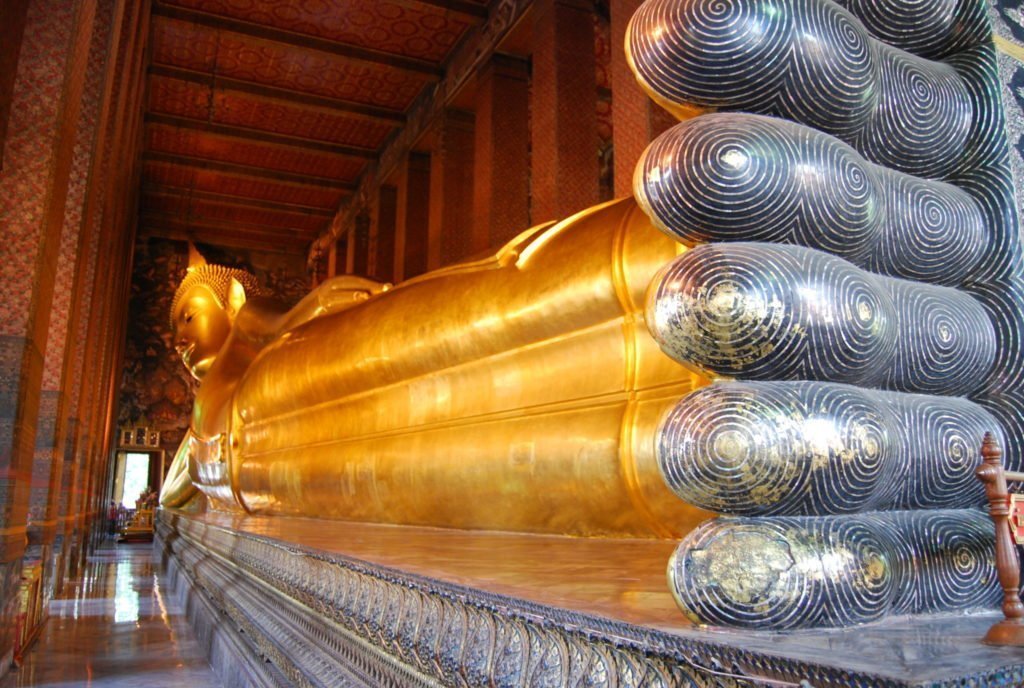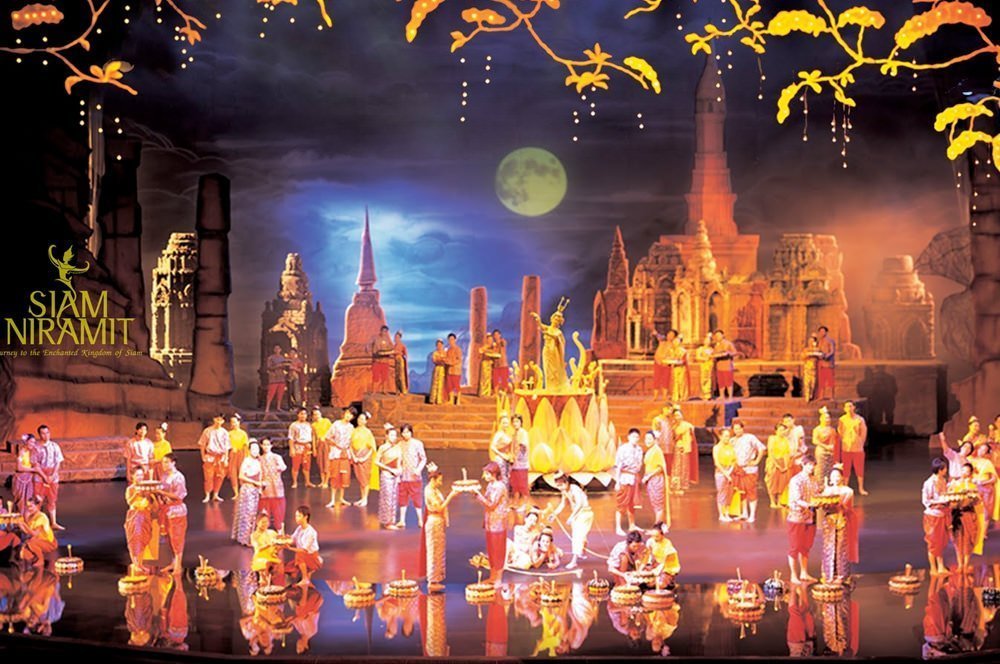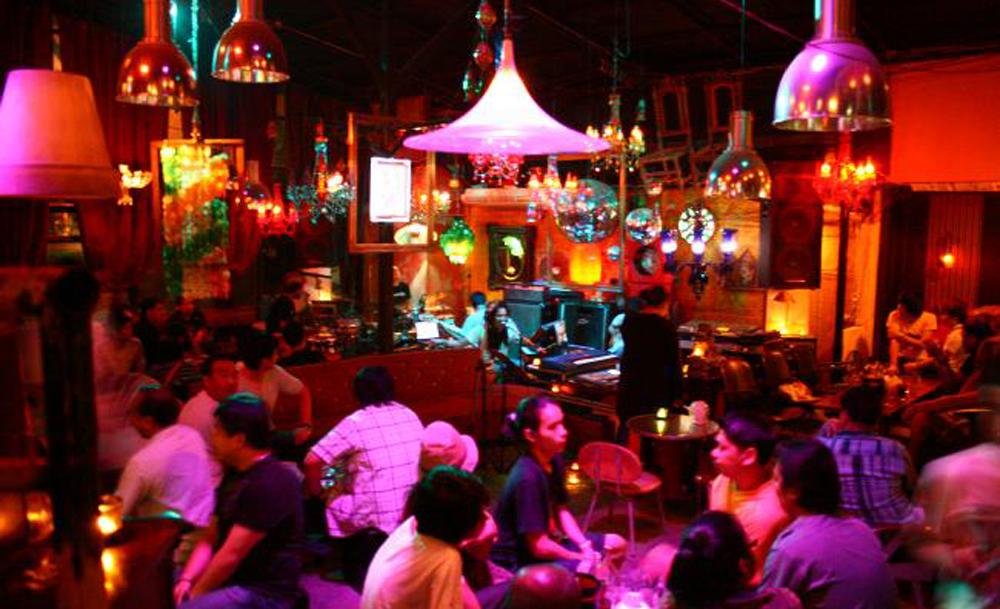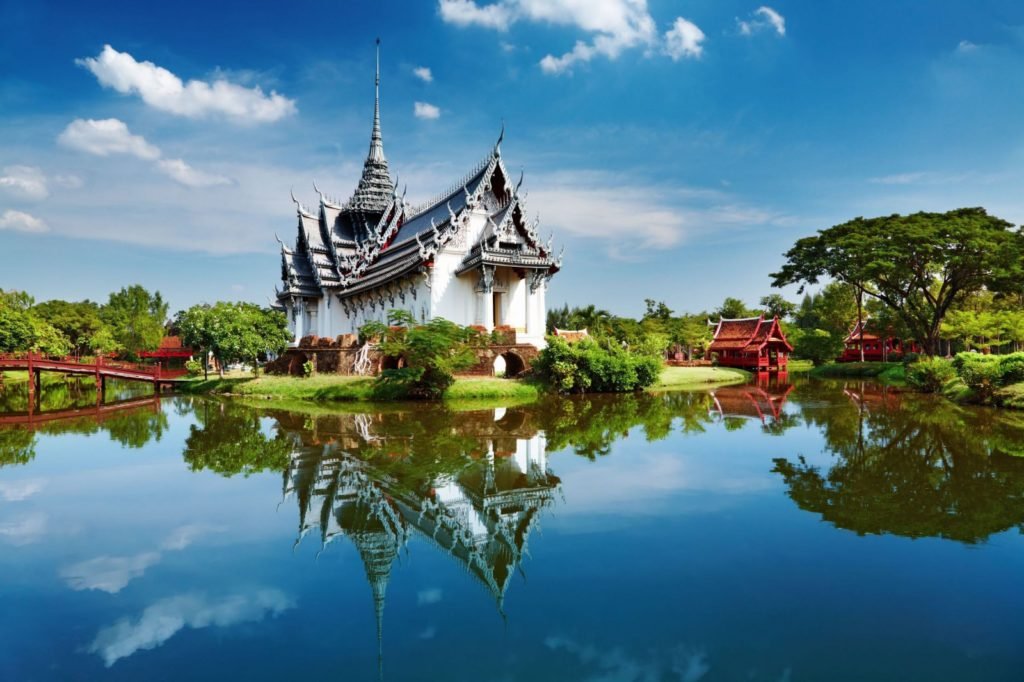Bangkok Capital Of Thailand
Discover Thailand with Thailand Discovery
Bangkok Capital Of Thailand, is a sprawling metropolis known for its ornate shrines and vibrant street life. The boat-filled Chao Phraya River feeds its network of canals, flowing past the Rattanakosin royal district, home to the opulent Grand Palace and its sacred Emerald Buddha temple. Nearby is Wat Pho with its enormous reclining Buddha and, on the opposite shore, Wat Arun with its steep steps and Khmer-style spire.
Wat Arun The Temple of dawn

Bangkok Capital Of Thailand
After the fall of Ayutthaya, King Taksin ceremoniously clinched control here on the site of a local shrine and established a royal palace and a temple to house the Emerald Buddha. The temple was renamed after the Indian god of dawn (Aruna) and in honour of the literal and symbolic founding of a new Ayutthaya.
At time of research, the spire of Wat Arun was closed until 2016 due to renovation. Visitors can enter the compound, but cannot climb the tower.
It wasn’t until the capital and the Emerald Buddha were moved to Bangkok that Wat Arun received its most prominent characteristic: the 82m-high þrahng (Khmer-style tower). The tower’s construction was started during the first half of the 19th century by Rama II and later completed by Rama III. Not apparent from a distance are the ornate floral mosaics made from broken, multihued Chinese porcelain, a common temple ornamentation in the early Ratanakosin period, when Chinese ships calling at the port of Bangkok discarded tonnes of old porcelain as ballast.
Also worth an inspection is the interior of the bòht . The main Buddha image is said to have been designed by Rama II (King Phraphutthaloetla Naphalai; r 1809–24) himself. The murals date from the reign of Rama V (King Chulalongkorn; r 1868–1910); particularly impressive is one that depicts Prince Siddhartha encountering examples of birth, old age, sickness and death outside his palace walls, an experience that led him to abandon the worldly life. The ashes of Rama II are interred in the base of the presiding Buddha image.
Frequent cross-river ferries run over to Wat Arun from Tien Pier (3B).
Wat Phra Kaew & Grand Palace

Bangkok Capital Of Thailand
Also known as the Temple of the Emerald Buddha, Wat Phra Kaew is the colloquial name of the vast, fairy-tale compound that also includes the former residence of the Thai monarch, the Grand Palace.
This ground was consecrated in 1782, the first year of Bangkok rule, and is today Bangkok’s biggest tourist attraction and a pilgrimage destination for devout Buddhists and nationalists. The 94.5-hectare grounds encompass more than 100 buildings that represent 200 years of royal history and architectural experimentation.
Housed in a fantastically decorated bòht (ordination hall), the Emerald Buddha is the temple’s primary attraction.
Except for an anteroom here and there, the buildings of the Grand Palace are now put to use by the king only for certain ceremonial occasions, such as Coronation Day, and are largely off-limits to visitors. Formerly, Thai kings housed their huge harems in the inner palace area, which was guarded by combat-trained female sentries. Outer palace buildings that visitors can view include Borombhiman Hall , a French-inspired structure that served as a residence for Rama VI (King Vajiravudh; r 1910–25). The building to the west is Amarindra Hall (open from Monday to Friday), originally a hall of justice and more recently, for coronation ceremonies, and the only palace building that tourists are generally allowed to enter. The largest of the palace buildings is the Chakri Mahaprasat , the Grand Palace Hall. Last is the Ratanakosin-style Dusit Hall , which initially served as a venue for royal audiences and later as a royal funerary hall.
Guides can be hired at the ticket kiosk; ignore offers from anyone outside. An audio guide can be rented for 200B for two hours.
Admission for the complex includes entrance to Dusit Palace Park , which includes Vimanmaek Teak Mansion and Abhisek Dusit Throne Hall.
Wat Po Bangkok

Bangkok Capital Of Thailand
You’ll find (slightly) fewer tourists here than at Wat Phra Kaew, but Wat Pho is our fave among Bangkok’s biggest sights. In fact, the compound incorporates a host of superlatives: the city’s largest reclining Buddha, the largest collection of Buddha images in Thailand and the country’s earliest centre for public education.
Almost too big for its shelter is Wat Pho’s highlight, the genuinely impressive Reclining Buddha .
The rambling grounds of Wat Pho cover 8 hectares, with the major tourist sites occupying the northern side of Th Chetuphon and the monastic facilities found on the southern side. The temple compound is also the national headquarters for the teaching and preservation of traditional Thai medicine, including Thai massage, a mandate legislated by Rama III when the tradition was in danger of extinction. The famous massage school has two massage pavilions located within the temple area and additional rooms within the training facility outside the temple.
Siam Niramit

Bangkok Capital Of Thailand
A cultural theme park, this enchanted kingdom transports visitors to a Disneyfied version of ancient Siam with a brightly coloured stage show of traditional performance depicting the Lanna Kingdom, the Buddhist heaven and Thai festivals.
A free shuttle-bus service is available at Thailand Cultural Centre MRT station, running every 15 minutes from 6pm to 7.45pm.
Chatuchak Weekend Market
Bangkok Capital Of Thailand
Among the largest markets in the world, Chatuchak seems to unite everything buyable, from used vintage sneakers to baby squirrels. Plan to spend a full day here, as there’s plenty to see, do and buy. But come early, ideally around 10am, to beat the crowds and the heat.
There is an information centre and a bank with ATMs and foreign-exchange booths at the Chatuchak Park Office , near the northern end of the market’s Soi 1, Soi 2 and Soi 3. Schematic maps and toilets are located throughout the market.
Friday nights from around 8pm to midnight, several vendors, largely those selling clothing, accessories and food, open up shop in Chatuchak. There are a few vendors on weekday mornings, and a daily vegetable, plant and flower market opposite the market’s southern side. One section of the latter, known as the Or Tor Kor Market , sells fantastically gargantuan fruit and seafood, and has a decent food court as well.
Once you’re deep in the bowels of Chatuchak, it will seem like there is no order and no escape, but the market is arranged into relatively coherent sections. Use the clock tower as a handy landmark.
Antiques, Handicrafts & Souvenirs
Section 1 is the place to go for Buddha statues, old LPs and other random antiques. More secular arts and crafts, such as musical instruments and hill-tribe items can be found in Sections 25 and 26. Baan Sin Thai sells a mixture of kŏhn masks and old-school Thai toys, all of which make fun souvenirs, and Kitcharoen Dountri specialises in Thai musical instruments, including flutes, whistles, drums and CDs of classical Thai music. Other quirky gifts include the lifelike plastic Thai fruit and vegetables at Marché , or their scaled-down miniature counterparts nearby at Papachu .
Clothing & Accessories
Clothing dominates most of Chatuchak, starting in Section 8 and continuing through the even-numbered sections to 24. Sections 5 and 6 deal in used clothing for every Thai youth subculture, from punks to cowboys, while Soi 7, where it transects Sections 12 and 14, is heavy on the more underground hip-hop and skate fashions. Somewhat more sophisticated independent labels can be found in Sections 2 and 3, while tourist-sized clothes and textiles are in Sections 8 and 10.
For accessories, several shops in Sections 24 and 26, such as Orange Karen Silver , specialise in chunky silver jewellery and semiprecious uncut stones.
Eating & Drinking
Lots of Thai-style eating and snacking will stave off Chatuchak rage (cranky behaviour brought on by dehydration or hunger), and numerous food stalls set up shop between Sections 6 and 8. Long-standing standouts include Foontalop , an incredibly popular Isan restaurant; Café Ice , a Western-Thai fusion joint that does good, if overpriced, pàt tai (fried noodles) and tasty fruit shakes; Toh-Plue , which does all the Thai standards; and Saman Islam , a Thai-Muslim restaurant that serves a tasty chicken biriani. Viva 8 features a DJ and, when we stopped by, a chef making huge platters of paella. And as evening draws near, down a beer at Viva’s , a cafe-bar that features live music.
Lumpini Park Muay Thai Stadium
Bangkok Capital Of Thailand
The other of Bangkok’s two premier Thai boxing rings has moved to fancy new digs north of town. Matches occur on Tuesdays and Fridays from 6.30pm to 11pm, and on Saturdays at 4pm to 8.30pm and from 9pm to 12.30am. At time of research there were plans underway for a Thai boxing museum and a school for foreign fighters.
It’s located well north of central Bangkok; the best way to get here is via taxi from BTS Mo Chit or MRT Chatuchak Park.
Parking Toys
Bangkok Capital Of Thailand
One of Bangkok’s best venues for live music, Parking Toys hosts an eclectic revolving cast of fun bands ranging in genre from rockabilly to electro-funk jam acts.
To get here, take a taxi heading north from BTS Mo Chit (or the MRT Chatuchak Park) and tell the driver to take you to the Kaset intersection and turn right on Th Kaset-Navamin; Parking Toys is just past the second stoplight on this road.
Bangkok’s Ancient City
Bangkok Capital Of Thailand
Don’t have the time to see Thailand’s most famous historic monuments? Then consider visiting scaled-down versions of them in what claims to be the largest open-air museum in the world. It’s an excellent place to explore by bicycle (daily hire 50B) as it’s usually quiet and rarely crowded.
Ancient City lies east of Bangkok outside Samut Prakan, which is most conveniently accessed via the park’s shuttle bus from BTS Bearing station (see website for departure times).
Amphawa Floating Market

Bangkok Capital Of Thailand
This afternoon-only floating market is located near a temple, WatAmphawanChetiyaram, where parking is provided. On Fridays and on weekends, the Amphawa Canal brims with boats loaded with drinks like O-Liang (Thai iced black coffee) and food such as fried sea mussels, noodles, and sweets. Bank-side wheelbarrows also offer goods for sale. Visitors can explore the market, tasting the local food, as well as hire a boat at night to watch as pretty fireflies light up the air.
In 2008, the KhlongAmphawa community was granted an Honorable Mention Award from the UNESCO Asia–Pacific Heritage Awards for Culture Heritage Conservation as a result of its efforts to preserve the local culture and architecture.
To get there by bus, take the Bangkok–Ratchaburi–DamnoenSaduak bus and get off at Amphawa Market. By car, take Highway 35 (Thon Buri–Pak Tho) to Km 63. Drive through the town of SamutSongkhram to take Highway 325 (SamutSongkhram–Bang Phae). At Km 36-37, take a left turn toward the King Rama II Memorial Park. The market is located near the King Rama II Memorial Park.
The market is open Fridays, Saturdays, and Sundays, from 12.00 pm-8.00 pm.
Khao San Road

Bangkok Capital Of Thailand
Perhaps the best known Bangkok’s district among young and budget travelers,Khao San Road is a short street located a kilometer north of the Grand Palace. Described by Alex Garland in his best selling book The Beach as “the centre of the backpacking universe,” Khao San Road certainly has everything a single backpacker would need: a wide range of budget accommodations, an array of restaurants and bars offering international foods and drinks, an army of food trucks offering Pad Thai (and other Thai street dishes), money exchange counters, tour operators preparing packages to elsewhere in Thailand and neighboring countries. Before turning into a travelers’ hub, Khao San was one of Bangkok’s main rice (khao san in Thai) trading port, and that’s where its name came from.
With its convenient location, travelers staying on Khao San Road can easily get around the old town on foot or bicycle, visiting Bangkok’s cultural landmarks like The Grand Palace,Temple of the Emerald Buddha, Wat Pho, the City Pillar Shrine, the National Museum and the National Gallery.
During the annual Songkran (Thai New Year, every April 13-15) Festival, the street of Khao San turns into one of Thailand’s main celebrating spots you can expect extravagant parades, entertainment showcases and big water splashing event.
[wp-review id=”14273″]




